The best umbrellas in 2024, tried and tested
Content is created by CNN Underscored’s team of editors who work independently from the CNN newsroom. When you buy through links on our site, CNN and its syndication partners may earn a commission. Learn more
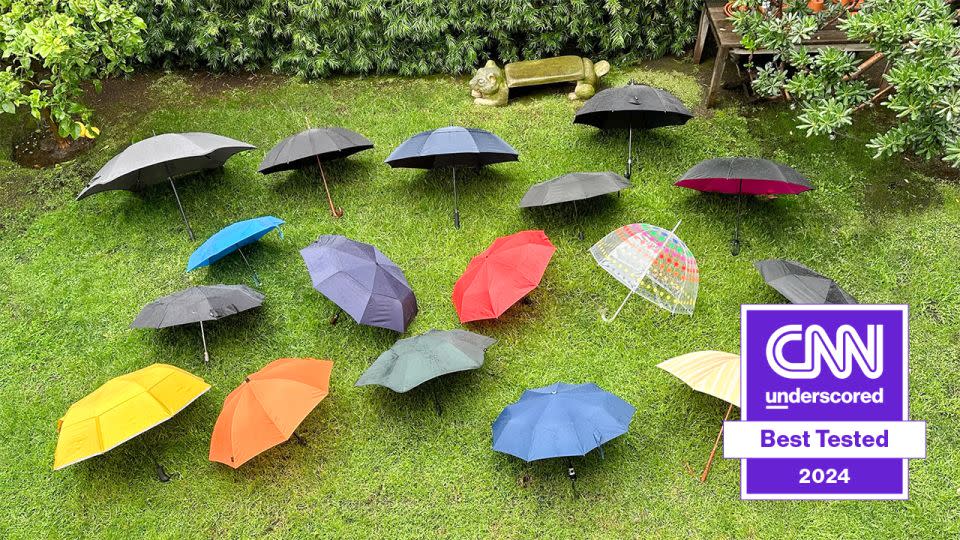
Umbrellas aren’t the most exciting products to shop for, but if you live in a wet climate, finding a reliable one is definitely worth your time. Otherwise, when your current drugstore umbrella inevitably snaps in the middle of the next downpour, you’ll wish you’d made a smarter purchase. To help find the best umbrella overall, and better distinguish between types, sizes and brands, I put 19 popular models to the test.
During a particularly rainy February in Los Angeles, I studied their coverage and canopy shape while trudging through downpours, held them out my car window to test their wind strength, constantly opened and closed them to judge mechanics and researched their materials to better determine long-term durability. After comparing my data, I can confidently declare the Balios Folding Double-Canopy Umbrella as the best overall.
Balios Folding Double-Canopy Umbrella
Best umbrella
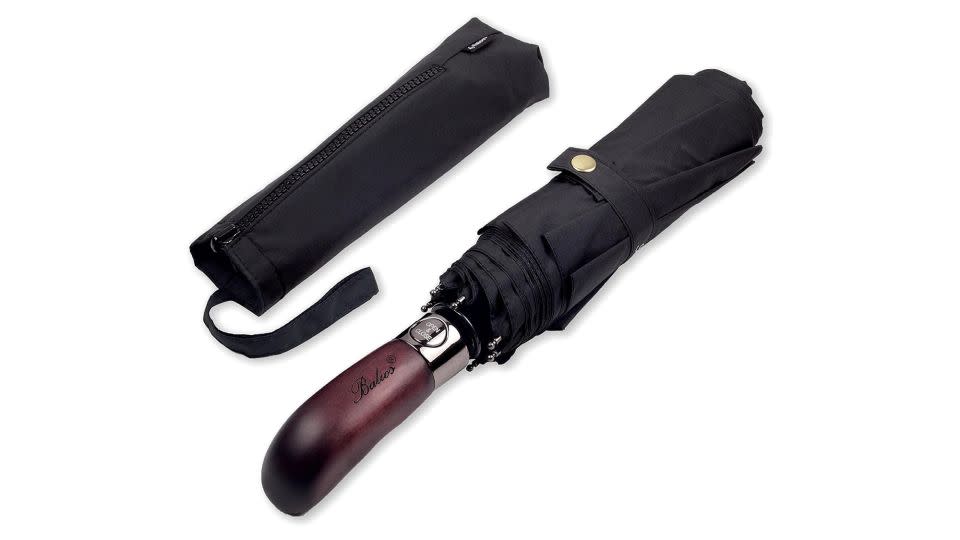
Compact, affordable, and sporting a polished wooden handle, the Balios Folding Double-Canopy Umbrella is a stylish and reliable option. It has the most comfortable handle of any umbrella we tested and a vented canopy that’s easy to fix if flipped inside out. With a 40-inch canopy and 13.8-inch length when closed, it also strikes a useful balance of functionality and portability.
Best umbrella: Balios Folding Double-Canopy Umbrella
$27 at Amazon
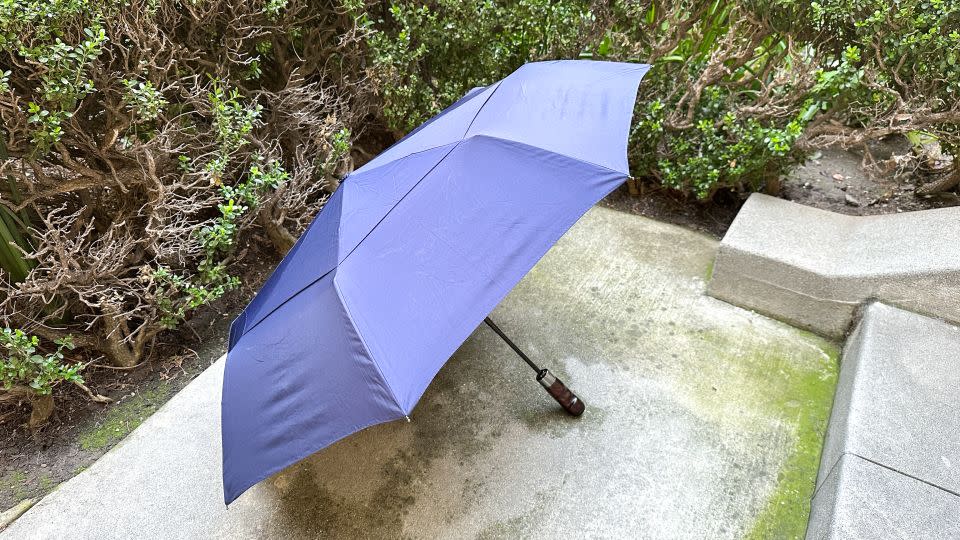
Combining a high-end look, user-friendly design and budget-conscious price, the Balios Folding Double-Canopy Umbrella is our pick for best umbrella. This folding umbrella opens and closes with the push of a button (although like all collapsable models, you still need to press it down to fully close) and provides a wide — but still maneuverable — 40-inch diameter canopy. The button is positioned where your thumb naturally sits on the handle and is unobstructed by the closed canopy, and the powerful action doesn’t have any delay like some weaker options. When closed, the canopy wraps up tight and tidy with a metal snap as opposed to the Velcro wraps of most other umbrellas.
My favorite feature of this umbrella, and what really separates it from the competition, is the design of the handle. Unlike most folding umbrellas that tend to shrink their handle as much as possible, the Balios Folding Double-Canopy Umbrella handle is long enough to grasp securely, and the ergonomic design fits your hand comfortably. This natural grip made it the most comfortable umbrella to hold and use, and even when wet, I never felt like I was struggling to maintain a solid grip. Its polished wooden construction also gives the entire umbrella a classic, high-end look, which is a nice perk considering the sub-$30 price tag. When closed, the length of the handle also prevents the pointed tips of the canopy from poking and covering up your hand, an annoying design flaw that I found with several folding models.
The Balios Folding Double-Canopy Umbrella also performed well during real-world testing, and its steel and fiberglass ribs withstood 18-mph winds before inverting. This speed wasn’t the highest of the folding models I tested (that belongs to the Totes Titan Portable Travel Umbrella, which inverted at 28 mph), but I found that its ability to revert quickly without any noticeable stress to the ribs or supports, to be a good sign for long-term durability.
While using the Balios during several downpours, the 9-inch depth of its canopy provided some of the best rain coverage of the folding models I tested — behind the 3-inch larger and $100 more expensive Davek Solo — and did a great job of directing rain and runoff away from my body. It also did so without obstructing my view too much, unlike the shallow, 6-inch depth of the AmazonBasics Standard Travel Umbrella with Wind Vent or the 6.5 inches of the Lewis N. Clark Travel Umbrella, which weren’t as effective against rain coming in at an angle. When the wind picked up, the vented canopy also helped me maintain more control than I could with non-vented models when marching forward, allowing air to escape without creating an immediate parachute effect.
Measuring 13.8 inches long when closed, this umbrella is convenient to carry and store when not in use, and at just 14 ounces, it won’t add much weight to your bag or backpack (only the Davek Mini and Lewis N. Clark Travel Umbrella were lighter). The Balios also features a 300-thread-count polyester canopy, which is dense enough to force water droplets to bead off immediately and really comes in handy when shaking off excess water before walking indoors. Although quite a few competitors are shorter by an inch or two (and the tiny Davek Mini is half the length at just 7 inches when closed) the functional and stylish handle is worth the extra length.
If you want an umbrella that’s sturdy, has a comfortable grip and a high-end look — without the stiff price tag — the Balios Folding Double-Canopy Umbrella is the umbrella for you.
Everything you need to know about umbrellas
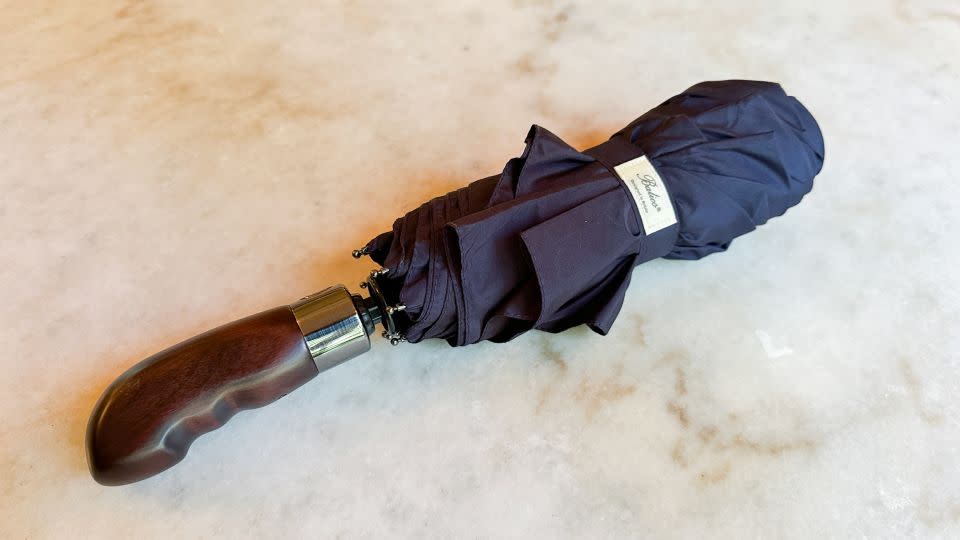
To choose the best umbrella for you, it’s important to understand the different types and how they work.
The two types of umbrellas are folding and straight. Folding models (sometimes called collapsible umbrellas) use an extendable shaft and folding ribs that shrink down when you’re done using them, while straight (or stick) umbrellas have a fixed shaft. Their compact size makes folding versions more convenient for storing in a backpack or bag when not in use, though with more moving parts that can break or fail, they’re also less durable than straight models. The length and overall strength of straight umbrellas allow them to have larger canopies, which increases protection from the rain but could also be less convenient when maneuvering through busy streets.
Both folding and straight umbrellas can open and close manually by pushing a support collar up the shaft and locking it in place or automatically by pressing a button on the handle. While many folding models can also close automatically, stick umbrellas do not. Although manual options might sound like the inferior option, many people prefer the simplicity and hassle-free operation, and well-made options don’t require as much effort as you might think. Again, with fewer moving parts, a big allure of manual umbrellas is their durability. That being said, the convenience and portability of a folding model is worth the compromise to most people, and like our top pick, the Balios Folding Double-Canopy Umbrella, features like a vented canopy and fiberglass components can help mitigate potential durability issues.
Both types of umbrellas can use different materials as well. Lower-quality models typically have aluminum ribs and supports, which can eventually bend and snap if stressed. More expensive models incorporate fiberglass components, which can bend and flex without snapping. Although all-fiberglass umbrellas are expensive, they’re also durable enough to last a long time.
How we tested
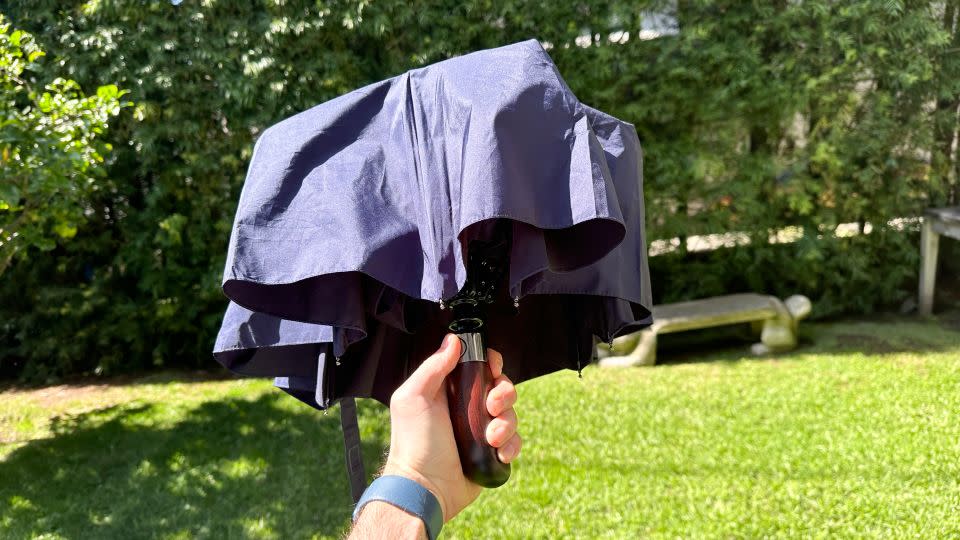
Umbrellas aren’t the easiest products to differentiate when attempting to choose a decent option. To determine the best overall umbrella, and better describe which options are better suited for different use cases, we ran all 19 umbrellas through a comprehensive testing process.
Usability
Operation: Since you’ll likely be using an umbrella in rainy weather and want to reduce the time spent unprotected, it’s important that your umbrella is easy to use. I utilized each umbrella’s opening and closing mechanism — both automatic and manual models — and noted if they were straightforward and user friendly.
Closure System: I did the same with the usability of their closure system, evaluating the canopy folds, the width of the closure strap (wider is typically better), as well as how those straps were secured (either Velcro or a metal snap).
Handle: I compared how comfortable the handles were to hold for different periods of time, if any control buttons were positioned in a convenient and helpful way, and if they offered wrist straps for hands-free security.
Performance
Coverage: I also tested each umbrella in several real-world rainstorms, taking note of how well they protected me from the rain. In particular, I paid attention to how low on my body the coverage was effective, and if the canopy design and shape made my legs or torso more wet than others did.
Control: I also made sure to note how well I was able to maintain control of the umbrella when the wind picked up, and if any specific features — like vented canopies — worked effectively.
Water repellency: After each test, I evaluated each umbrella’s canopy material and its ability to expel water when shaking off and bringing the umbrella inside.
Comfort: This rain test, along with additional dry walks with the canopy opened, also gave me a good idea of how comfortable each model was to hold above my head for long periods of time.
Portability
Size and Weight: To better compare overall portability, I closed each umbrella and carried it around my house, around the block and in and out of my car, noting how easy it was to close and wrap up, how comfortable it was to carry and if it could fit inside a backpack or tote bag.
Construction
Material: I researched and inspected the design of each umbrella’s ribs and internal supports, noting whether they were made with lower-quality metals or strong and flexible fiberglass that tends to bend rather than break.
Strength: I opened each umbrella out of the passenger window of my car and accelerated down an empty street until it inverted inside out. I logged the precise speed where this inversion occurred, which gave me a nice solid number to compare the overall strength of each umbrella. (It’s worth noting that I didn’t accelerate past 30 mph, as this began to affect the steering of the car. There were a few models that failed to invert at 30 mph, so I can’t be sure how they would have eventually stacked up against one another, but I made sure to note this strength in their summaries below.)
Inversion: This test also showed me how easily each umbrella was able to revert back to normal, and which ones were difficult or even broke when attempting to revert. Although these results aren’t as accurate as one done in a controlled wind tunnel — I’m sure slight variations in canopy angle or acceleration speed can affect results — I still think it gives a ballpark idea of how one umbrella may differ from another.
Other umbrellas we tested
Davek Solo Umbrella
$115 $98 at Davek with code CNNDAVEK
This Davek umbrella is on the pricier end of the budget spectrum — and by far the most expensive folding model in my testing pool — but if you’re interested in a high-quality, compact model that’s built to last, this is a fantastic option. The open and close button has a smooth, powerful feel to it, and the nine support ribs (almost all collapsible umbrellas have eight) resisted inversion up to 25 mph in my strength test. The ball-shaped handle and wrist strap are both made of stitched leather and give the unit a distinct high-end look (though I imagine some might prefer a longer, more ergonomic handle for better grip). The 43-inch canopy, the widest of all folding models I tested, provides plenty of coverage, and the 8.5-inch depth kept me drier than most folding umbrellas during testing.
Davek Elite Umbrella
$159 $135 at Davek with code CNNDAVEK
Another high-end Davek model, this straight umbrella radiates class and quality, with a stitched leather J-handle and shiny chrome accents. This quality extends to the internal components as well, which feature all-fiberglass ribs, struts and shaft. The 43-inch canopy pops open automatically at the push of a button and retracts easily by pulling down on the collar. The 25-ounce weight is heavier than most stick umbrellas, but the curved handle still made it comfortable to carry when unopened and allows you to hook it on your forearm for hands-free transport. Plus, this curved handle helped me maintain a strong grip in heavy wind, even when the heavy-duty frame refused to invert at 30 mph. If you live in an especially windy area and don’t have a problem with the high price tag, this umbrella is a great option, but we think it’s a bit much and too expensive for most.
Davek Mini Umbrella
$60 $51 at Davek with code CNNDAVEK
This tiny umbrella was even smaller than I expected, and at just 7 inches when closed, it’s 4 inches smaller than the next shortest models in my testing pool. Though this size makes the Davek Mini easy to store and transport (an extra-wide Velcro strap really wraps it up tight when closed), I’m not sure the small canopy is worth the portability. At only 34 inches in diameter (the smallest of any in my testing pool) and just 7 inches deep, you’re really not getting much coverage, causing it to rank the worst in my real-world rain test. The tiny handle also doesn’t provide a very good grip, though the elastic wrist strap was easy to slip over my hand. The overall construction of this umbrella felt sturdy and solid, though, and kept its shape until I reached 20 mph in my wind speed test. Davek clearly prioritizes quality and customer satisfaction (you’re getting the same lifetime warranty as the other Davek models), so if portability is your top priority and you don’t mind compromising on coverage, I’d consider this a fine option.
Business & Pleasure Co. The Rain Umbrella
$100 at Business & Pleasure
This chic umbrella is about as adorable as they come, with a variety of classic, vintage color patterns available and a whimsical wooden handle. Unfortunately, these aesthetics are its strong suit, as it ranked very low when it came to strength and overall durability. Even though its 25-mph inversion test ranked about average for straight umbrellas in my testing pool, two of its plastic ribs shattered when I attempted to right it. Although the 37-inch canopy’s 13-inch depth provided a decent amount of coverage, its polyester material also absorbed water more easily than umbrellas that utilized a densely woven or Teflon-coated canopy.
Blunt Metro Umbrella
$89 $79 at Amazon
Instead of sharp points, Blunt brand umbrellas have rounded tips on their canopies, which does a great job of strengthening where the ribs meet the edge of the canopy — a common site of ripping and tearing. This design gives the canopy a taut, solid feel and also lets you confidently move through crowds without worrying about poking or injuring someone. With a frame made of fiberglass and aluminum, this umbrella felt much more stable than the lower-quality options that had rattly or cheap-feeling components. Although its 15-mph strength test ranked the lowest in my testing pool (tied with the Repel Windproof Travel Umbrella and AmazonBasics Travel Umbrella with Wind Vent), this sturdy frame pops back to normal without much effort. Unfortunately, the scalloped canopy edges seem to sacrifice some rain coverage, and it lacked the protection of similarly sized models. This canopy also frustratingly overlaps the handle when closed, making it less than convenient to open and close quickly. The 15-inch length is bulky for a collapsible model too, which might be an issue for those looking for an ultra-portable option.
Blunt Sport Golf Umbrella
$149 $135 at Amazon
Featuring the largest canopy of all the umbrellas I tested, this 58-inch golf umbrella provides a ton of coverage and, combined with its 14-inch depth, kept me bone-dry in heavy rain. Despite this large size, the manual operation was surprisingly easy to use, featuring a wide extension collar that smoothly opens and closes the canopy. The rubber, ergonomic grip of the handle made this beast of an umbrella comfortable to carry and control, although at 35.2 ounces, it’s the heaviest model I tested. Using the same round-tipped canopy as the Blunt Metro Umbrella, this design eliminates any dangerous points and stretches the canopy nice and taut with minimal stress on the fabric. The all-fiberglass frame, including the shaft, gives the unit a durable, strong feel, and I never felt any rattling or wobbling when swinging it around. The bulky size affects its portability a bit, but it does include a sleeve and shoulder strap for convenient transport. It’s not cheap, and probably overkill for most, but considering the high-quality materials and sturdy construction, I consider this umbrella worth the investment.
Repel Windproof Travel Umbrella
$35 $24 at Amazon
This compact folding umbrella features a whimsical blue-sky pattern underneath the canopy (clearly inspired by the famous MoMA Sky Umbrella) and opens and closes at the push of a button. (There are also solid colors available.) The aluminum and fiberglass ribs are more flexible than most, and although this resulted in its rock-bottom ranking in my strength test — inverting at 15 mph — it also contributes to its overall durability. Unlike more rigid models, this rib design is flexible and resilient, reverting easily and with minimum stress to the joints and connections. It didn’t have the double-vented canopy as advertised, though, and the 37-inch canopy didn’t provide much protection.
AmazonBasics Standard Travel Umbrella With Wind Vent
$20 $15 at Amazon
The button to open and close the umbrella works well, and while the handle is shorter than most, its curved shape offers an ergonomic grip. The 6-inch-deep canopy is flatter than every other umbrella I tested, though, and resulted in a wetter than average rainy-day test. It also ranked in the bottom of the strength test, inverting at 15 mph (though this shallow depth allowed it to revert back to normal pretty easily). The vented canopy helps maintain control from wind in any direction, and although the canopy material doesn’t repel water as well as Teflon-coated models, I still found it relatively easy to shake off excess water when walking indoors.
Weatherman Collapsible Umbrella
$74 at Weatherman
Sturdy, strong and featuring a cavernous canopy, this Weatherman umbrella performed better than any collapsible model in my rain coverage test. Even though the canopy diameter is 40 inches (about average for the collapsible umbrellas in my pool), the 11-inch depth (which is 2 inches deeper than my top pick, the Balios Folding Double-Canopy Umbrella) allowed it to sit nice and low around my shoulders, keeping me dry in heavy downpours. This depth seems to contribute to its overall strength (it resisted inversion when driving up to 25 mph), but it also makes it harder than most to revert back to its original shape. The super-sturdy fiberglass rib and support system resisted my attempts to do so, and even though I eventually succeeded, it wouldn’t be very fun to do in a rainstorm. Weighing 23 ounces and measuring 19.5 inches long when closed, which was the heaviest and bulkiest of my folding group, it’s also the least portable.
Totes Signature Clear Bubble Umbrella
$30 $24 at Amazon
If maximum rain protection is your priority, and you’re fine with a one-person umbrella, you won’t beat this clear bubble option. Its 16.75-inch depth was the deepest in my testing pool, totally enveloping my head and shoulders in heavy downpours. What’s really nice about this model is that despite this depth, the canopy still has just a 33-inch diameter, so it doesn’t take up much room on a busy sidewalk. The manual open and closing mechanism works well and refused to invert at 30 mph. Although the transparent canopy is obviously easier to see through than other umbrellas, its plastic material lacks the water-repellent quality of polyester or nylon models. This makes it easier for raindrops to cling to the surface, which not only affects vision but also means it’s harder to shake dry when coming inside.
Totes Eco Wooden Stick Umbrella
$23 $18 at Amazon
A handsome, old-school option at an attractive price, this Totes stick umbrella features a large wooden J-handle that’s both comfortable to hold and convenient to hang and hook when not in use. It flies open with a powerful whomp at the push of a button, and closing it manually requires little effort. The 42-inch canopy fared near the top of its class in my rain test, using its 15-inch depth to cover my head and shoulders effectively. It inverted at 20 mph in my strength test and was able to revert relatively easily. Though it feels sturdy enough, the internal ribs and supports are made primarily of aluminum, unlike the all-fiberglass ribs and supports of more expensive umbrellas.
Totes Titan Portable Travel Umbrella
$24 at Amazon
An effective compact option, this Totes umbrella is just 11 inches long when closed and provides a 39-inch diameter canopy (similar to our top pick, the Balios Folding Double Canopy Umbrella). I also appreciate the extra-wide closure strap, which wraps up the folded canopy nice and tight, and the elastic wrist strap is easier to use than most nonflexible versions. The automatic open and close mechanism works well, but I felt that the plastic handle lacked the grip and stability of rubber or wood, and it gives the umbrella a cheaper look overall. This umbrella did perform very well in my strength test, though, and its 28-mph inversion was the best of any folding option. However, for a few of dollars more, I consider our top pick, the Balios Folding Double-Canopy Umbrella, a much better option.
Lewis N. Clark Travel Umbrella
$14 From $13 at Amazon
This budget-friendly option provides a 39-inch canopy and made it to an impressive 23 mph before inverting in our strength test. Its 10-ounce weight is also one of the lightest in our testing pool, and only the tiny Davek Mini Umbrella weighed less at 8 ounces. This low price does seem to translate to lower-quality materials, unfortunately, and the unit itself lacks the sturdiness of more expensive options, with a noticeably rattly shaft and rough aluminum supports that scraped against my knuckles while closing it. But I did appreciate the wide strap used to wrap it up, which results in a tight and tidy package for convenient transport. If you’re looking for a cheap model that’s compact enough to store easily and has a reasonably strong frame, you could do a lot worse.
EuroSchirm Swing Liteflex Trekking Umbrella
$50 at Amazon
Extremely lightweight and just plain fun to use, this EuroSchirm model features the simple mechanics of a stick umbrella without the usual bulk and weight. Despite its mere 9-ounce weights, its canopy shape has a decent amount of depth, and even though it has a relatively small diameter at 37.5 inches, it was effective at keeping me dry in my rainy-day testing. While the foam handle is comfortable to hold, it’s so short that it actually recesses into the closed canopy. This design causes it to overlap your hand when attempting to close it, which isn’t a deal breaker but is annoying to deal with every time you use it.
ShedRain UnbelievaBrella Reverse Umbrella
$30 at Amazon
Once I got used to the unique upside-down design of this 42-inch ShedRain umbrella, I found it easy to use and very smooth to operate manually. This upside-down design drained water better than traditional umbrellas when closing it up, but I also suspect that it’s the reason for its low strength rating. It inverted at 18 mph, but the circular handle was easy to hold on to when things got windy. That being said, it was the easiest umbrella I tested when it came to reverting back to a normal shape, which bodes well for its long-term durability. The relatively shallow canopy provided a lot of visibility during my real-world rain tests but didn’t protect me as well as others against angled rain. Overall, this model provides a wide canopy without being too intrusive and has a sturdy feel to it, and you can’t beat that lifetime warranty.
G4Free Golf Umbrella
From $29 at G4Free
I’m not exactly sure how an umbrella that’s as large and sturdy as this one has such a low price tag, but if that’s what you’re looking for, it’s a fantastic choice. The massive 45-inch canopy launches open with the push of a button and somehow manually retracts back down without much effort. It kept the majority of my body dry during rainy walks, and the vented design helped me maintain control when things got windy. It refused to invert, even at 30 mph, and the reinforced fiberglass struts and shaft give me confidence that this unit is built to last. Although the foam handle is comfortable to hold, it didn’t have the tacky feel that made the Blunt Sport Golf Umbrella so easy to control, and I’m a little concerned with the long-term durability of the foam itself. The 24.6-ounce weight and 37-inch length aren’t the most practical when it comes to portability, but it does include a storage sleeve with a built-in shoulder strap to help in that department.
Note: The prices above reflect the retailers' listed price at the time of publication.
For more CNN news and newsletters create an account at CNN.com

